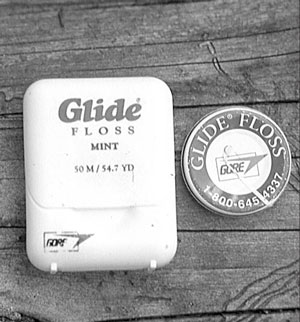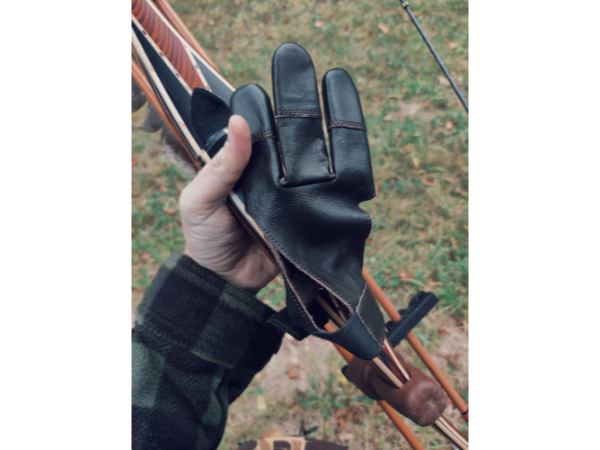This is an excerpt from T.J.’s book, The Traditional Bowhunter’s Handbook.
Many archers enjoy the sound their bowstring makes when loosing an arrow. It is one of those unique sounds that, along with the flight of the arrow, makes shooting a bow such a wonderful experience. However, for the bowhunter bowstring noise is an undesirable thing that needs to be eliminated if any level of bowhunting success is to be attained.
One of the most frustrating experiences a bowhunter encounters is when a deer or other game animal seems to “jump the string” when an arrow is released at close range. This is mainly the result of the animal hearing the release of the arrow or, more likely, the thump and resulting vibration of the bowstring at release. “Jumping the string” is the wrong term. Slow motion video of this event will show the animal actually drops down to gather its legs before springing from the noise. The result of this squatting and gathering of legs is the arrow flying harmlessly over the animal.
When a bow is shot, the energy from the limbs must go somewhere. Ideally, you want all the energy to go into pushing the arrow forward. However, this is not possible and some of the energy is transferred back into the limbs when the bowstring comes to the end of its power stroke when the arrow leaves the bowstring. The result of this energy transfer can be excessive handshock as discussed in Chapter 11, or noise caused by vibration. Since you will most likely be using an arrow of correct weight and spine (see Arrow Spine and Weight and Chapters 14 and 15), we can assume that any handshock will be removed. So what we’re left with is noise caused by vibration of the bowstring.
There are several ways to reduce bow noise or dampen this vibration. Black Widow and 3Rivers Archery sell an item they call the Limb Saver that attaches to the limbs of a bow to help reduce vibration and noise with a minimum loss of performance. These look somewhat like a black rubber mushroom. Most archers prefer to attach silencers to their strings to quiet the vibration. The most common string silencers are either Puff Silencers, which are made from yarn; Beaver Balls, made from tanned beaver hide; Cat Whiskers or Spider Legs, made from precut rubber; or tanned coyote hide. Each of these styles work to varying degrees, but some are better suited than others for all-around bowhunting conditions.
Coyote or Beaver Balls are more traditional than plastic and rubber, and many archers prefer this type of silencer. But I have found that hunting in wet conditions pretty well nullifies any advantage they might possess. Despite what the package says about their being waterproof, after one day of hunting Sitka blacktails on Kodiak Island mine simply hung limp on the string and failed to dampen any noise.

Black Widow makes their own string silencers that are placed between the bowstring strands and work quite well. This set-up uses dual silencers on each end of the bowstring.
Black Widow carries leather string silencers that look like spider webs that work quite well and go with the Black Widow motif.
Kwikee Kwiver makes a plastic silencer that has been around for many years. They are star shaped with three points and are attached by threading the bowstring through them. They work, but don’t look as traditional or work as well as other material.
Puff Silencers are made from durable yarn and do an excellent job of dampening string vibrations. I have these installed on a few of my bows and for the most part have never had a problem with them. However, on a recent deer hunt in Montana the yarn became a magnet for all the burrs I was walking through. The end result was a solid mass of tangled yarn and burrs, almost negating their sound-dampening qualities.
Of all the silencers I have tried, nothing seems to work as well for me in all conditions as Cat Whiskers. Their elasticity makes them ideal for absorbing the string’s vibration, and they work in all weather conditions. But they have one small disadvantage and that is that they are not UV (ultraviolet) resistant. This means that they will break down in the sun and must be replaced often or they will simply fall apart after a while. I hunt all year long, every chance I get, so my bow spends much of its time in the field. I find that I may have to replace my Cat Whiskers two or three times a year. However, I don’t find this a problem; when I replace them I also do other string maintenance such as replace the serving and wax the string. It’s all part of the game.

If using Cat Whiskers, separate the bowstring and place each Whisker in between the strands. Use dental floss—I like Glide floss from Gore—and make a crisscross or figure eight around the rubber as shown and then tie off.
Here’s a little trade secret when it comes to Cat Whiskers; you can buy this material in bulk from any of the bigger sporting goods mail order houses, like Bass Pro Shops or Cabela’s, which sells it as bass popper leg material; Cabela’s calls it their Skirt Factory. It comes in several different colors, in ten yard pieces. I bought two packages of black over a decade ago for $22 and still have about 30 feet of the stuff left even after giving away as much as I could to friends. To keep it from rotting during storage, I keep it in an aircraft camera film container I picked up while in the service many years ago. It stays cool and protected from light, and it is as good today as it was when I bought it. I expect it will last me the rest of my life!
There are several ways to add a string silencer to your bowstring. One way is to tie the material directly to the string. This will work, but the silencer most likely will slip down the bowstring, and it looks rather bad. A better way is to tie the material in between the strands of the bowstring.

One way to install the string silencer in between the string is to remove the string from the bow and stretch it out between two nails on a work bench. You can use a thick rubber band on one end to keep the string taut while you proceed. Once you have the string taut and secure, separate the strands evenly. I shoot a 16 strand string, usually of two
colors, so I simply separate the colors knowing they are evenly divided. Slip the silencer—in my case, I use Cat Whiskers or popper leg material—between the two separate strand bundles making sure the material bisects the string evenly on both sides. A good place to start is approximately six to ten inches down from one of the string loops. I then use Glide Floss to secure the Cat Whiskers in place. Glide Floss is made by Gore, the same folks who make Gore-Tex, and this floss is extremely tough, much more so than any other floss, and will take one heck of a beating in the field. It is similar to Teflon, the same thing that Gore-Tex sells to make waterproof garments. Tie the floss in a crisscross pattern or in a figure eight around the Whiskers, making sure it is tight and snug against the string. About two or three figure eights will suffice. Tie off the floss with at least two knots and secure the knots with super glue. Add another silencer to the other end of the bowstring at about the same location and repeat the tying process. Trim the extra floss so that it is as flush as possible and brace the string back on the bow. Once the bow is braced, grab the Cat Whisker and pull taut while slowly cutting across the Whisker with a pair of sharp scissors. This will force the Whiskers to separate into a dozen or so legs as shown in the image.

Pull the rubber taut and cut diagonally with a pair of scissors to release the separate strands of the material.
A much easier way to install string silencers is to use an E-Z String Separator. The E-Z allows you to separate the bowstring while it is strung on your bow. Shaped in a U design, it has an insertion point on one end and a string guide on the other, allowing you to insert it into the string, turn 90 degrees, and secure the guide over the bowstring. It opens up the bowstring enough to allow you to slip your silencers through, tie them off, then remove the E-Z from the string. It is vinyl coated and will not damage your bowstring.
Some bows, or some shooting styles, may require additional silencers to get them quiet enough for bowhunting. In these instances, place one set about four inches from the string loops and an additional set another six to eight inches from there. Make sure the silencer material does not interfere with your shooting.







I think this article outlines the various string silencer methods well. I have recently started using rubber bands as a silencer. I have always used wool yarn puff balls, but felt that I needed something more to make my bow even quieter. So in a pinch, i took two rubber bands and tied one to the top and one to the bottom. It works great – better than any cat whiskers that I\’ve tried. I tried a few combinations of this. Feeding through the string, cutting the rubber bands, tying the rubber bands on and then cutting, tying them on and then leaving looped… of all, the latter worked the best to quiet the bow. It has been a very cheap and effective way to silence my bow.
I think personal tip from experience is some of the Best advice thanks for a Good , inexpensive tip .Keep em coming . Jjr
Always s use them silencers ,might buy yourself a second shot if you missed the first,great for your compound Bow aswell.Softest rubber or beaver ,mink fur are Best ” love the woods and they will love You back ” jjr
I’d be nice if you would include instructions on how to attach beaver balls to the bow
Thanks tradbow for the clear instructions.
Rubber string silencers are good and cheap . separate the string and tie a knot pulling the rubber tight and there you go. make sure you get the strips that are made for silencers as they will separate evenly . Just pull them apart when you have on the string. Used on my recurve and long bows for years when hunting. they have 4 foot length at epay will last for ever. water dost not absorbed into rubber. Dose not slow the bow down like other things do.